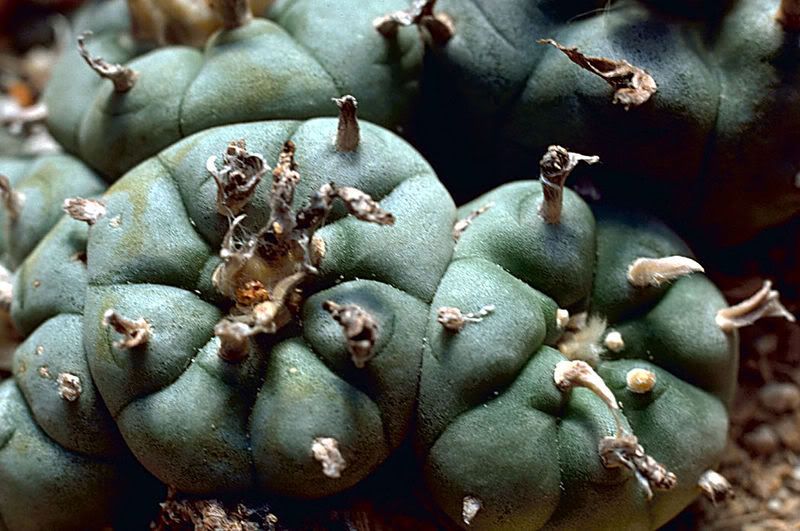Lophophora (John M. Coulter, 1894) is a genus of spineless, button-like cacti native to the southwestern United States (Texas and New Mexico) through Northeast Mexico and South to Querétaro. The species are extremely slow growing, sometimes taking up to thirty years to reach flowering age (at the size of about a golf ball, not including the root) in the wild. Cultivated specimens grow considerably faster, usually taking between three to ten years to reach from seedling to mature flowering adult. Due to this slow growth and over-harvesting by collectors, the species are considered to be in danger of extinction in the wild.
 Species
SpeciesLophophora has been reported to be comprised of everything from one species, L. williamsii with varieties, to the four species L. diffusa, L. fricii, L. viridescens, and L. williamsii. Most modern authorities consider Lophophora to be a genus of two species, L. diffusa and L. williamsii. Recent DNA sequencing studies (Butterworth et al. 2002) have shown that L. diffusa and L. williamsii indeed are distinct species. DNA evidence from the alleged species L. fricii and L. viridescens would allow for more accurate classification. Below is given a key for the currently accepted species along with the "species" and varieties that must be considered synonymous. Detailed arguments for this classification can be found in Peyote: The Divine Cactus (Anderson 1996, pp. 210-219).
Lophophora diffusa (Croizat) Bravo 1967 The plants are yellow-green, usually lacking well-defined ribs and furrows. The podaria are rarely elevated, but are broad and flat. The tufts of hair are usually spread unequally on the prominent podaria. The flowers are commonly whitish to yellowish-white. L. diffusa occurs at the south end of the range of the genus in Querétaro state, Mexico.
L. diffusa contains none to trace amounts of mescaline; pellotine is the principal alkaloid.
Several people have reported that this cactus is psychoactive if ingested, though the experience is not similar to peyote. This species looks almost identical to peyote, though it is legal to possess.[citation needed]
Synonyms
* Lophophora echinata var. diffusa Croizat 1944
* Lophophora williamsii var. diffusa (Croizat) Rowley 1979
* Lophophora diffusa var. koehresii Riha 1996, L. williamsii var. koehresii (Riha) Grym 1997 * Lophophora diffusa subsp. viridescens Halda 1997, L. viridescens (Halda) Halda 1997
Lophophora williamsii (Lemaire ex Salm-Dyck) J. M. Coulter The plants are blue-green, usually with well-defined ribs and furrows. The tufts of hair are usually equally spaced on the ribs. The flowers are pinkish or rarely whitish. L. williamsii occurs in the full range of the genus except in Querétaro state, Mexico.
The mescaline content in dried L. williamsii can reach 6%.
Synonyms
* Echinocactus williamsii Lemaire ex Salm-Dyck 1845
* Lophophora lewinii (K. Schumann) Rusby 1894
* Lophophora echinata Croizat 1944
* Lophophora fricii Habermann 1974, L. williamsii var. fricii (Habermann) Grym 1997, L. diffusa subsp. fricii (Habermann) Halda 1997
* Lophophora jourdaniana Habermann 1975 One curious and under-reported observation is that these cacti have thigmotactic anthers. This means that as its anthers are touched they curl over, depositing their pollen. This movement can be seen by gently poking the anthers of an open Lophophora flower. Thus one of the slowest growing plants in the world makes one of the fastest plant movements!
Ethnobotany, Ethnomedical, and Entheogen Use
* Lophophora williamsii, commonly known as peyote, is noted for its psychotropic alkaloids; see peyote for further details.
* These alkaloids are absent or only found in extremely small amounts in the other species Lophophora diffusa. While L. diffusa is known for having psychoactive effects, these effects are described not so much as "visionary", like peyote, but rather a delirious high such as those associated with the use of Datura and Belladonna.
* The stem is used as a spiritual hallucinogen, and is applied topically as a galactogogue, or lactation aid[citation needed].
Etymology
Lophophora means "crest-bearing", referring to the tufts of trichomes that adorn each tubercle. The name is derived from the two Greek words λοφος (lophos, the crest of a hill or helmet) and φορεω (phoreo, to carry).
References
* Edward F. Anderson, The Cactus Family (Timber Press, 2001) ISBN 0-88192-498-9, pp. 396-397
* Edward F. Anderson, Peyote: The Divine Cactus (University of Arizona Press; 2nd edition, 1996) ISBN 0-8165-1654-5
* Lyman Benson, Cacti of the United States and Canada (Stanford University Press, 1983) ISBN 0-8047-0863-0, pp. 680-683
* C. A. Butterworth & J. H. Cota-Sanchez, & R. S. Wallace (2002), ”Molecular systematics of Tribe Cacteae (Cactaceae: Cactoideae): A phylogeny based on rpl16 intron sequence variation”, Systematic Botany 27 (2), 257-270.
* John M. Coulter, Preliminary revision of the North American species of Cactus, Anhalonium, and Lophophora (Contributions from the U. S. National Herbarium 3(2), 1894) * Rudolf Grym, Rod/Die Gattung Lophophora (Vydavateľstvo Igor Dráb, 1997) ISBN 80-85441-11-X

No comments:
Post a Comment